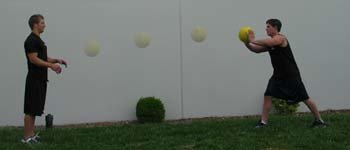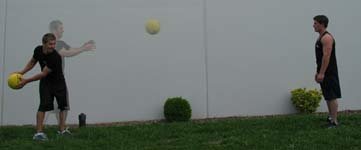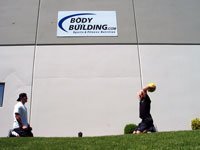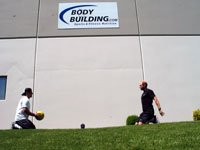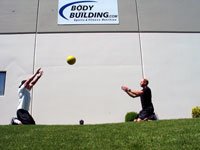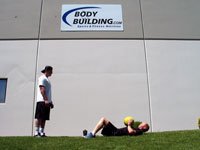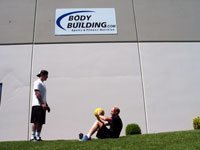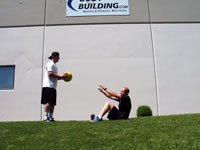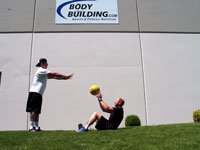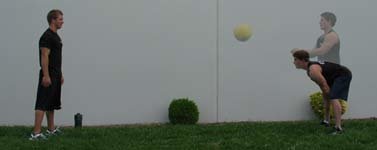
Introduction

The ability to generate strength and power is a very important component for success in many sports, particularly in those involving explosive movements. Medicine ball training, in conjunction with a program of weight training and circuit training, can be used to develop strength and power. Certain medicine ball exercises can also be used as part of plyometric training program to develop explosive movements. Medicine ball training is appropriate to all levels of ability, age, development and sport. To be most effective the program should contain exercises that match the pattern of movements of the sport.
Your body adapts, it improves, and it grows. Exercise does not produce these gains, but it merely stimulates your body to produce them. The key factors in growth are stimulation and overcompensation. Stimulation is a result of high-intensity training. The overcompensation is related to your body's ability to recover from training variables. This is all good for growing, but what about the development of strength-speed and balance?
Well, we all know, that in any workout, strength is a common output. Speed- strength training is the combination of your maximum speed, in any movement, incorporated with maximum strength, thus producing power.
Most speed-strength techniques are designed from methods combining weight training, speed development drills, and the use of plyometrics. Traditionally we build strength by lifting weights via resistance training. We use running as the common exercise for endurance. Medicine ball training, in many ways, does all the above.
We will be utilizing three components of speed-strength training for our medicine ball training, and they are:
- Explosive strength - the greatest amount of force developed in a time from start to finish.
- Starting strength - the measurement of how fast and forceful the motion is at the beginning.
- Reaction strength - the speed in which the initial body movement causes an opposite and increased reaction from the second movement that occurs to the follow through.
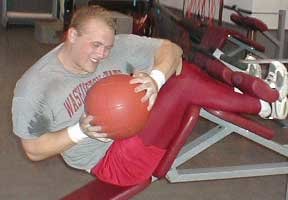

Are You Ready For Some Balls?

A medicine ball throw stimulates the hand and upper body muscles. Medicine ball workouts are very similar to a weight-training program. They must be done with correct technique, a certain number of sets, and a minimal amount of repetitions for maximal gains to be produced.
Catching and throwing of medicine balls, or jelly balls, are used to develop arm and upper body speed, strength, and balance. Performing medicine ball exercises will enable you to work on weaknesses, and inconsistencies in your musculature. Furthermore, medicine balls can be used to duplicate the isometric contraction. Plus, they render a generated explosion of power from the release of a medicine ball. So, when you execute a movement with speed, you quite naturally try to place all your power behind that particular movement.

This is called muscle strength, and its development is important for your punching and striking techniques. It's like when you throw a punch, your only going to have as much speed and strength as you've perfected. That speed and strength could equate sufficient enough for you. But, if you make contact before your opponent, and you have no power behind it, then you might find yourself wishing you were somewhere else.

Force & Stress

It is important to understand that certain exercises place a tremendous amount of stress on your joints. When incorporating your medicine ball drills into your current workout, the time spent on ball exercises and drills will be about ten minutes. The number of drills should not be less then two, but not exceed five. Like any other ballistic movement, if you do too much to often your power output will decrease and your overall explosive strength will decrease also. That is not what we are looking for. This program is not outlined for that either. So, do not assume that more is better.
Perform medicine ball drills 2-3 times a week, on non-consecutive days, like Tuesday and Thursday. Remember, medicine balls are weighted, and some of them can get up to 25 pounds. Most of you might not think that is a lot of weight, but after about sixty seconds of tossing that heavy ball around, your arms will feel like Jell-O! That is why these balls are so productive to developing speed, strength, balance, and endurance.
Before beginning any medicine ball program begin centering. What is centering? Centering is basically a method of gaining composure immediately before, or during a workout or competition. This involves three stages; lowering the level of body consciousness, elimination of negative thoughts, and concentration on the most important aspects of your performance. Furthermore, centering will also accelerate improvement of your breathing technique, and improve your confidence levels too. This will help you in achieving top fulfillment for throwing and catching.

The Workout

Perform an active warm-up first. This will increase blood flow to the proper muscles. Active warm-up, along with your regular flexibility routine, should be performed at the start of your medicine ball program. This will prepare you for higher intensity activities. Try doing these exercises before you begin your medicine ball drills.
- Overhead Twist - In a standing position, the feet are shoulder width and the medicine ball is held over head with arms locked. Move the ball slowly left to right and then right to left. This stretches the upper torso and low back.
- Twist - Identical to the overhead twist except the medicine ball is held in front of the athlete with arms locked; the athlete twists from side to side. Stretches the lower back.
- Drill 1: Chest press throw
- Drill 2: Side arm throw
- Drill 3: Standing & Kneeling overhead throw
- Drill 4: Sit-up and long throw
- Drill 5: Underhand & overhead throw
The medicine ball chest press, between two partners, is executed by making the passes as forceful and as quick as possible. Cushion the ball all the way to your chest, but repel it back as quickly as possible. Stand about 4-5 feet away from each other. Always keep the same distance between each other. Do not change distances. Perform 3 sets of 8 repetitions.
Drill #2
The side arm pass is performed in the same manner as the chest press throw. Face your partner about 4-5 feet away, and then have your partner throw the ball to you at your side. Catch the ball with both hands, follow through, and return the ball back to your partner as quickly as possible with all the force you can generate. Perform 3 sets of 8 reps.
Drill #3
Both individuals facing each other, similar to the two above drills, but kneeling on both knees perform the kneeling overhead throw. Have your partner toss the ball to you in an overhead throw. Catch the ball over your head. Immediately and as quickly as possible, with all your force, throw the ball back. Again execute 3 sets of 8 reps. This will work the internal and external oblique, and the spinal region.
Drill #4
Performing a sit-up and long throw is probably the most difficult of these exercises. While sitting down, knees bent in a sit-up position about three feet apart from your partner, place a medicine ball midpoint on your chest. Now, as you crunch up into a sit-up throw the ball towards your partner in a two handed chest pass. Your partner should then send the ball back to you in a parallel direction. This will place you catching the ball over your head, and recoiling back into a sit-up position. Repel the ball back as quickly as possible. Perform 3 sets of 8 reps.
Drill #5
To execute an underhand and overhead pass stand 4-5 feet away and have your partner throw the ball below your waist. The ball should be caught between your legs. Return the ball forward and upward towards your partner, quickly and hard, so that your partner has to catch the ball overhead. Repeat and then change directions for 3 sets of 8 reps. This movement also works oblique and spinal integrity, and body stabilization. The intensity can be picked-up by the speed at which you and your partner pass the balls back and forth. But first, get used to the motion and technique of the movements before increasing the speed and throwing action.
| Tuesday Sample Workout | |
| Chest Press Throw | 3 sets of 8 reps |
| Side Arm Throw | 3 sets of 8 reps |
| Underhand & Overhead Throw | 3 sets of 8 reps |
| Thursday Sample Workout | |
| Kneeling Overhead Throw | 3 sets of 8 reps |
| Sit-up and Long Throw | 3 sets of 8 reps |
| Underhand & Overhead Throw | 3 sets of 8 reps |

Accepting Throwing

An effective work out with medicine balls can be achieved in about 30 to 40 minutes. Carry out two or three sessions per week with a recovery period of 36 to 48 hours between sessions. Each session should be made up of different exercises with the athlete performing 2 to 3 sets of each exercise. If the athlete is to develop strength and muscular endurance then conduct 6 to 12 repetitions. If the athlete is to develop muscular endurance rather than strength then conduct 15 to 25 repetitions. By incorporating medicine ball training into your ordinary grueling workouts, and combining the above program with the Power Athlete Football Training routine you will solidify a base of explosive strength, reaction strength, starting strength, and balance. We all know how important it is to take your medicine. Only if you want to get better!
Looking for Medicine Balls?
M-F Athletic Company
P.O. Box 8090
Cranston, RI 02920
1-800-556-7464
Speed City
For a FREE catalog call
1-800-255-9930
Bigger, Faster, Stronger
1-800-628-9737
About The Author
Curtis is a contributing writer for various health, bodybuilding, and collegiate sports publications. Curtis has a B.S. in Sports Administration and is a Level I USWF Olympic Coach. He is a collegiate strength coach who has worked with many high-level athletes ranging from NFL stars to top-level bodybuilders. Powerlifting State and Regional champion in the 242 and 275 classes. He is also an AAU and USPF referee. Curtis was a three-year Varsity football letter winner, All-greater Rochester Lineman in high school, and then Junior College and University All-conference lineman.






